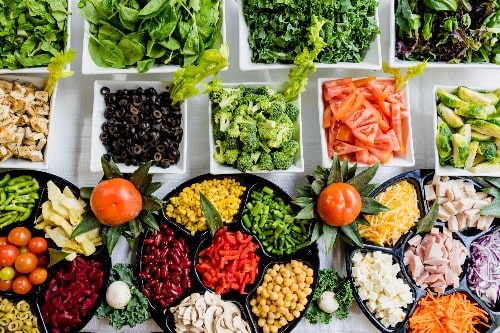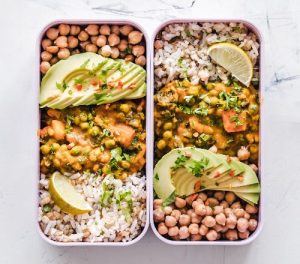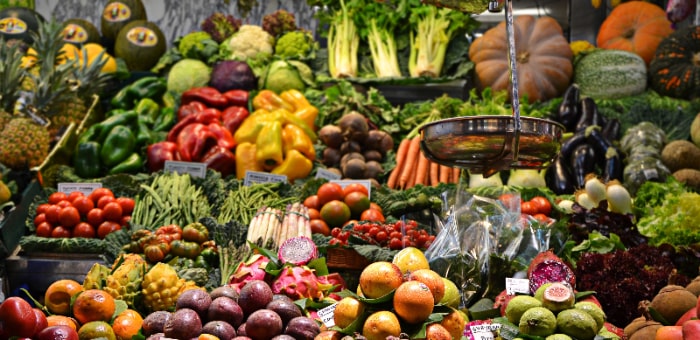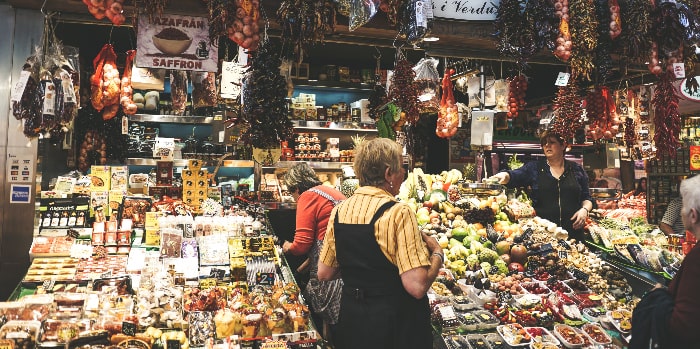Healthy meal prep doesn’t have to be a chore. All you need is a bit of planning and organization. Plan your meals for the entire week so you can create a detailed shopping list. If you try to cook a quick meal and don’t have the right ingredients, cooking becomes a chore; you’re likely to feel frustrated. A healthy lifestyle depends on fresh, home-cooked food that nourishes your body and soul.
Healthy Meal Prep Idea #1: Bulk Cooking
One of the easiest techniques for healthy meal prep is bulk cooking. Make a large quantity of several items, and you’ll have food for 3 days or more. If you’re the type of person who’s easily bored and likes variety in your daily meals, you can still take advantage of this idea. You’ll need to freeze several servings instead of eating the same thing every day. This works especially well with soups and stews. Or you can create a basic recipe and then change the seasonings for each meal.
Here’s an example:
- Cook a large pot of whole grains, such as brown rice or brown rice pasta
- Add chopped vegetables such as peas, carrots, onions, peppers, broccoli, cauliflower, or spinach
- Season with salt and pepper to taste and a few fresh herbs
- Store half of the mixture in the fridge or freezer (tightly sealed)
- Flavor up the reserved portion by making a sauce or stirring in extra ingredients:
- Asian – add soy sauce, fish sauce, rice vinegar, garlic, ginger, Thai basil or anything else you like
- Mexican – add tomatoes, cilantro, jalapenos, cumin, adobo
- Italian – add garlic, basil, balsamic, olive oil, tomatoes, or pesto
- Other – harissa (spicy), curry paste, chili peppers, olives, lemons
This creates a healthy foundation that can be used for several meals. Add some protein if you like: grilled wild fish or grass-fed beef. You can also whip up a stir fry to go on top of the grains. Or make a power bowl by adding steamed veggies and/or beans. Have a salad to start and a ripe piece of fruit for dessert. That’s a healthy meal!
Here’s a low-carb example:
- Roast several large trays of vegetables: zucchini, onions, peppers, broccoli, cauliflower
- Cook enough protein to last for several days, like a roast or a whole chicken
- Or you can prep your proteins, and wrap the portions in plastic and keep them in the fridge until you’re ready to cook
- Use the basic seasoning approach (above), and add flavor to each meal based on your preference
Make a large salad to start your meal. For dinner, have roasted veggies and protein. Fruit is low in calories and high in nutrients. Have some for dessert!
There are many strategies for bulk cooking. In winter, the easiest approach is to make a big pot of chili or soup. Include extra veggies in whatever you choose to cook, and throw in beans or legumes for fiber. Freeze leftovers in individual serving containers for a quick meal. You can always use the leftover chili as a topping for steamed vegetables or a burrito. In the summer, fire up the grill and cook extra portions of lean proteins and veggie kabobs.
Healthy Meal Prep Idea #2: Refrigerator Salad Bar

Salad is one of the healthiest and most versatile dishes on the planet. Raw vegetables provide abundant phytonutrients, water, and fiber. Adding more veggies and fruits to your eating plan is the top healthy living strategy. Most of us don’t get enough variety in our meals. Creating a salad bar in your fridge is an excellent way to spice up your healthy meals. It takes a bit of effort, but if you do the prep work in advance, you’ll have salad masterpieces for the whole week!
The most time-consuming part of prepping your salad ingredients is washing and chopping your produce. If you set aside an hour to get this chore done right, it will really pay off. The farmers market is the best source of local veggies; if you don’t have that option, try Whole Foods, Wegmans, or Fresh Market. They have a large selection of organic and high-quality produce. Go food shopping trip once per week, and buy a BIG variety! Don’t be afraid to experiment.
Here are some veggie prep ideas to get you started:
- Celery — cut off the end of the stalk, wash thoroughly in a colander. Leave the stalks whole, but shave off any dark spots and peel some of the strings off of the large stalks. The tender inner hearts can be left whole. Wrap the clean stalks in a damp paper towel and store them in a plastic bag in the fridge. You can also cut the large stalks into celery sticks … these are great for snacks. They will dry out in a couple of days, so cut only as many sticks as you’ll eat in that time frame. By leaving them whole, the water is retained and you can easily cut or chop them later in the week.
- Carrots — clean well, remove the tops and peel them. Like celery, they’ll retain their water better if left whole.
- Tomatoes — never refrigerate tomatoes; they lose their flavor. Wash and dry them thoroughly and leave on the counter. Cherry tomatoes are great for lunch boxes. It only takes a few seconds to chop a tomato into a salad.
- Radishes — wash them and remove the top stem. Cut off any dark spots, but otherwise leave them whole.
- Red cabbage — remove the tough outer leaves, then shred half the cabbage. The shredded cabbage will keep for several days. When you run out, or if it gets dry, shred the other half.
- Cucumbers — full of water. Too much advance prep turns them into a mushy mess. Buy mini cucumbers and peel them. Or if you don’t mind the peel, just wash them thoroughly. Leave them whole in the fridge; they make great snacks.
- Scallions — wash and strip off the outer onion layer. Cut off the end and store them whole.
- Peppers — wash and remove the tops and seeds. Cut into large strips; also great for snacks.
- Broccoli — wash well, and shave off the tough skin from the stalk. Broccoli stalks are quite delicious; try them! Break the florets into pieces and cut the stalks into sticks for snacks.
- Cauliflower — wash and break into florets. Remove the core. The tender cauliflower leaves are great in soups.
- Greens – leafy greens are a superfood. The easiest way to get a variety of healthy greens into your salads is to buy the organic, pre-washed packages. Try a mix of dark and light greens. Arugula, romaine, spring mix, watercress, mache — they all have amazing nutritional properties. Experiment!
- Beans and legumes — canned beans make a fiber-rich addition to salads. Be sure to buy them in BPA-free cans, and rinse the beans thoroughly. They’ll keep in the fridge for 3 days. Hint: homemade beans taste much better than canned.
- Fruits — berries are a great addition to salads. Wash them and cut off any bad spots. They usually only keep a few days, so be sure to eat them quickly. Apples and oranges make great salad additions; you can’t do much to prep them in advance. Dried fruits like cranberries, cherries, and dates are tasty salad toppings, and ready to eat!
- Cheese — dairy is generally not a healthy option (especially if you’re lactose intolerant). But if you tolerate dairy well, a little bit of cheese now and then can provide variety and flavor.
- Dressing — there are healthy salad dressings out there. Check the label to make sure the oil is healthy (avocado or olive) and there are no added sugars or chemicals. The best option is to make a healthy vinaigrette … just add a bit of olive oil and vinegar or lemon juice.
Every salad will be slightly different as you mix and match the ingredients. This prevents boredom. Even if you think you don’t like salad, once you bite into that crunchy deliciousness you’ll be hooked! Eating a salad before or with dinner helps digest the rest of your meal. When your digestion is functioning well, your immune system is powered up. You’ll also experience improved sleep when your dinner has been properly digested.
Healthy Meal Prep Idea #3: Pack Your Lunch While Making Dinner
Speaking of dinner, you can multitask if you prep tomorrow’s healthy lunch while you’re making dinner. Even if you work from home, you’ll find it easier to stay on a healthy eating plan if your lunch is prepped and ready to eat. For commuters, packing a healthy lunch will definitely be an improvement over your other choices. Fast food, convenience food, take-out and vending machines are generally not a source of healthy meals.
Buy a lunch box organizer so you can pack something delicious for lunch.

Leftover soup, stew or chili along with a healthy salad will keep you satisfied all afternoon. A large salad with lots of veggies, beans and maybe protein provides a balanced meal for lunch. Double your portions of proteins or starches when cooking dinner so that you have enough to pack for lunch.
Sandwiches work well for lunch too. Cook extra protein at dinner, and use this as a sandwich base. Keep the bread separate from your protein and salad ingredients. Assemble everything when you’re ready to eat. Your lunch box should have small containers for condiments and dressings. It’s worth the small investment!
While you’re packing lunch, make sure to include snacks. Pack a couple of apples or a container of fresh berries. Try to vary the contents of your lunches so you don’t get bored. Variety is a powerful tool to help you stay on the healthy living path!


